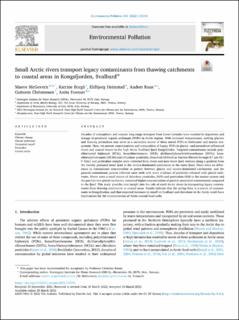| dc.contributor.author | Mcgovern, Maeve | |
| dc.contributor.author | Borgå, Katrine | |
| dc.contributor.author | Heimstad, Eldbjørg Sofie | |
| dc.contributor.author | Ruus, Anders | |
| dc.contributor.author | Christensen, Guttorm | |
| dc.contributor.author | Evenset, Anita | |
| dc.date.accessioned | 2022-10-25T04:59:07Z | |
| dc.date.available | 2022-10-25T04:59:07Z | |
| dc.date.created | 2022-04-07T09:48:52Z | |
| dc.date.issued | 2022 | |
| dc.identifier.citation | Environmental Pollution (1987). 2022, 304, 119191. | en_US |
| dc.identifier.issn | 0269-7491 | |
| dc.identifier.uri | https://hdl.handle.net/11250/3028041 | |
| dc.description.abstract | Decades of atmospheric and oceanic long-range transport from lower latitudes have resulted in deposition and storage of persistent organic pollutants (POPs) in Arctic regions. With increased temperatures, melting glaciers and thawing permafrost may serve as a secondary source of these stored POPs to freshwater and marine ecosystems. Here, we present concentrations and composition of legacy POPs in glacier- and permafrost-influenced rivers and coastal waters in the high Arctic Svalbard fjord Kongsfjorden. Targeted contaminants include polychlorinated biphenyls (PCBs), hexachlorobenzene (HCB), dichlorodiphenyltrichloroethanes (DDTs), hexachlorocyclohexanes (HCHs) and chlordane pesticides. Dissolved (defined as fraction filtered through 0.7 μm GF/F filter) and particulate samples were collected from rivers and near-shore fjord stations along a gradient from the heavily glaciated inner fjord to the tundra-dominated catchments at the outer fjord. There were no differences in contaminant concentration or pattern between glacier and tundra-dominated catchments, and the general contaminant pattern reflected snow melt with some evidence of pesticides released with glacial meltwater. Rivers were a small source of chlordane pesticides, DDTs and particulate HCB to the marine system and the particle-rich glacial meltwater contained higher concentrations of particle associated contaminants compared to the fjord. This study provides rare insight into the role of small Arctic rivers in transporting legacy contaminants from thawing catchments to coastal areas. Results indicate that the spring thaw is a source of contaminants to Kongsfjorden, and that expected increases in runoff on Svalbard and elsewhere in the Arctic could have implications for the contamination of Arctic coastal food-webs. | en_US |
| dc.language.iso | eng | en_US |
| dc.publisher | Elsevier | en_US |
| dc.rights | Navngivelse 4.0 Internasjonal | * |
| dc.rights.uri | http://creativecommons.org/licenses/by/4.0/deed.no | * |
| dc.title | Small Arctic rivers transport legacy contaminants from thawing catchments to coastal areas in Kongsfjorden, Svalbard | en_US |
| dc.type | Peer reviewed | en_US |
| dc.type | Journal article | en_US |
| dc.description.version | publishedVersion | en_US |
| dc.rights.holder | © 2022 The Authors | en_US |
| dc.source.pagenumber | 7 | en_US |
| dc.source.volume | 304 | en_US |
| dc.source.journal | Environmental Pollution (1987) | en_US |
| dc.identifier.doi | 10.1016/j.envpol.2022.119191 | |
| dc.identifier.cristin | 2015848 | |
| dc.source.articlenumber | 119191 | en_US |
| cristin.ispublished | true | |
| cristin.fulltext | original | |
| cristin.fulltext | original | |
| cristin.qualitycode | 1 | |

